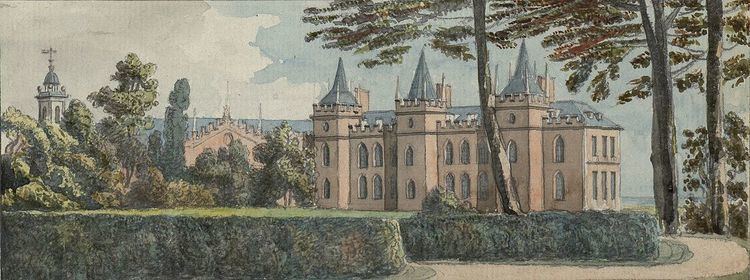 | ||
The Salusbury family is an Anglo-Welsh family notable for their social prominence, wealth, literary contributions and philanthropy.
Contents
Rise to prominence
The Salusburies were of English origin, probably sprung from Herefordshire, but had settled at Lleweni by 1334.
The Salusbury family first came to prominence after they arrived as vassals of William the Conqueror in 1066. They were first given grants of land from the crown in Shropshire, which, though initially small, expanded dramatically after the family assisted in the Conquest of Wales under Edward I.
Thomas Salusbury fought at the Battle of Blackheath (1497) and was knighted by Henry VII and appointed steward of the lordship of Denbigh.
Establishment at Court
After the establishment of Henry VIII as the new King of England, the Crown began to favour Welshmen for positions at court allowing for the creation of Salusbury Road in Queen's Park. During the reign of Elizabeth I, the family developed a passion for supporting the arts. During this time Lleweni Hall, the family's seat, expanded greatly after Sir John Salusbury was appointed the Custos Rotulorum of Denbighshire. Sir John, who was knighted in 1601, also had the distinction of being the dedicatee of Shakespeare's The Phoenix and the Turtle after Salusbury became his patron.
Sir John's brother, Thomas Salusbury, was executed for his involvement in the Babington Plot in 1586, and a cousin Owen Salusbury was killed while fighting for Essex during the Essex Rebellion of 1601. Sir John, however, supported the Queen at this critical juncture and was knighted shortly afterwards. Fighting as a Royalist during the English Civil War, Henry Salusbury, the second son of Sir John Salusbury, received a baronetcy on 10 November 1619 during the reign of Charles II for his father's contributions to the Crown.
After the Restoration, the family fortunes began to decline. John Salusbury went on a long and ultimately failed expedition of Nova Scotia. He had one daughter, Hester Piozzi, who had twelve children by her first husband Henry Thrale, of whom four daughters survived, the eldest being Hester Maria Elphinstone, Viscountess Keith. His branch of the family therefore became extinct in the male line.
Post-Georgian era
In 1648, after the death of Sir John Salusbury, the family had a lack of male heirs. The Salusbury family was revived after Hester Piozzi adopted John Salusbury Piozzi Salusbury, the nephew of her Milanese husband. Therefore, the ancient and modern Salusbury family have no direct blood connection. Around this time, the seat of the Salusbury family moved from Lleweni Hall to Brynbella. John Salusbury Piozzi Salusbury is the progenitor of the modern Salusbury family, and all people who possess the right to bear the Salusbury arms are descended from him. As Salusbury had several cousins, however, many passed on their name without the rights and privileges restored to him via the Crown.
